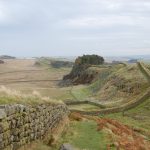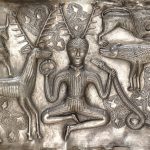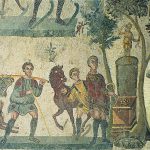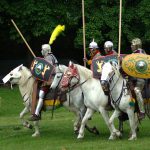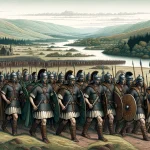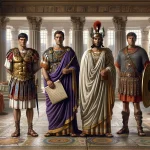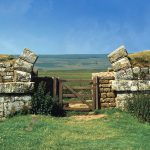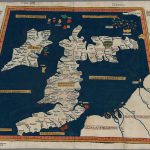The Cantiaci or Cantii tribe occupied the ancient land of Cantium, probably from the second century BC. The area comprised of the whole of modern Kent, with the eastern parts of Surrey, East Sussex and Greater London. Like many of their neighbours in the south-east, the Cantii were Belgic people from the North Sea or Baltics. They formed a recognisable territory which may not have been a single unified kingdom until the start of the first century AD, but which instead appears to have been several smaller kingdoms which operated as a confederation in times of trouble.
Next to these [the Atrebates], but farther eastward, are the Canti among whom are the towns: Londinium 20*00 54°00 Daruernum 21*00 54°00 Rutupie 21*45 54°00.
Above quote from the Geographia of Ptolemy (II.ii)
Caesar thought them the most civilized tribe in Britain, and recorded four kings each ruling a minor kingdom; Cingetorix, Carvilius, Taximagulus and Segovax, perhaps operating together under the authority of Cassivellaunus of the Catuvellauni. The material culture of the tribe has a strong Belgic influence.
Geographical features within the territories of the Cantiaci
Other passages in Ptolemy Book II Chapter 2 give the ancient names of a number of rivers and other geographical features within the territories of the Cantiaci tribe:
- Fretum Gallicum (Strait of Dover) constituting the 22-mile wide portion of Oceanus separating Britain from Gaul.
- Cantium Promonturium (South Headland) the famous ‘White Cliffs’ just north-east of Dover.
- Tanatus Insula (Isle of Thanet) in Roman times was completely separated from the Kentish mainland, before the silting-up of the Wansum Strait.
- Tamesis Aestuarium(Thames Estuary) delineates the northern borders of the canton.
The Civitas Cantiacorum The Principal Tribal Centre
Dvrovernvm Cantiacorvm (Canterbury, Kent)
Native pre-Roman settlement on the Stour in East Kent, later cantonal capital served by a port three miles down the Stour at Fordwich. Amminus (Adminius) minted coin bearing a mint-mark of DVN, which is thought to be an abbreviation of Durovernon, with the implication that he had a mint here.
The Tribal πολεις (Poleis or Settlements)Assigned by Ptolemy
- Londinivm (London, Greater London) – This busy port, later provincial capital of Roman Britain, was apparently sited within the ancient territories of the Cantiaci, which would extend their domain across the River Thames into southern Essex, encroaching upon the lands of the neighbouring Catuvellauni. This may have been an error by Ptolemy, but the two tribes are known to have had dynastic links and the area around the Thames had been in dispute for some time before the coming of Rome.
- Dvrovernvm (Canterbury, Kent) – The later Cantonal capital (see above).
- Rvtvpiae (Richborough, Kent) – The original Claudian bridgehead and invasion seaport, by the time of Ptolemy, the main port of entrance to Britain.
Other Settlements of the Cantiaci
- Dvrobrivae (Rochester, Kent) – Pre-Roman native settlement on the Medway in West Kent. One of only two walled towns in Cantium, the other being Canterbury. Rochester may have been the centre of a Roman administrative pagus.
- Maidstone (Kent) – A Roman settlement of some kind is suspected here.
- Loose (nr. Maidstone, Kent) – Pre-Roman native settlement on the upper Medway, south of the Len confluence.
The Industries of the Cantiaci
Villa’s were plentiful around Rochester but scarce around the cantonal capital at Canterbury. A number of pottery and tile kilns have been noted in the environs of Canterbury, but the chief pottery industries lay in the area of the Upchurch Marshes. Iron was mined in the Hastings area.
- Titsey (Kent) – This rural temple may mark the western border of the Canton.
- Hastings (Sussex) – This iron port had overland connections with the Cantiaci in Kent rather than with the Regnenses of Sussex.
Watling Street Itinerary Posting Stations
Other Itinerary Coastal Stations
Caesar’s Cantium
Julius Caesar’s Gallic Wars provides us with three references to ancient Kent. The first in a general description of Britain:
Julius Caesar, De Bello Gallico / The Gallic War, Book 5 Chapter 13
… The natural shape of the island [Britain] is triangular, and one side lies opposite to Gaul. Of this side one angle, which is in Cantium (where almost all the ships from Gaul come in to land), faces the east, the lower angle faces south. …
He goes on to speak of the people of Kent in glowing terms:
Julius Caesar, De Bello Gallico / The Gallic War, Book 5 Chapter 14
‘Of all the Britons the inhabitants of Cantium, an entirely maritime district, are by far the most civilised, differing but little from the Gallic manner of life. …’
And provides us with further snippets on the political geography, mentioning four Kentish rulers:
Julius Caesar, De Bello Gallico / The Gallic War, Book 5 Chapter 22
… Cassivellaunus¹ sent messages to Cantium, a country by the sea, as above set forth, over whose four districts Cingetorix, Carvilius, Taximagulus, and Segovax ruled as kings, and commanded them to collect all their forces for a sudden attempt and assault upon the naval camp². …
- Commander of the combined British force opposed against Caesar during his second British expedition of 54BC.
- The naval fortifications erected by Caesar (vide G.W. v.11) were located somewhere on the northern coast of Kent; the exact site will remain unknown as the area has been lost to the erosion of the sea.
The Kentish kings’ assault on the Roman naval camp was not to succeed, and their failure forced Cassivellaunus to come to terms with Caesar, who took hostages, levied tribute, and sailed swiftly back to Gaul before the seasons turned.
It is of note that Caesar always speaks of the region, Cantium, and nowhere provides us with the actual name of the tribe inhabiting the area.
Kings of the Cantiaci From Numismatic Evidence
Apart from the four kings mentioned by Caesar (vide supra), who were very likely responsible for a number of uninscribed coins attributed to this period, other Kentish kings have been identified from inscribed coinage recovered in the canton.
Dubnovellaunus
Perhaps one of several kings of the Cantiaci in the latter half of the first century BC, but certainly the first to issue inscribed coins. The styling of some of these coins is essentially Gaulic, suggesting a date perhaps around 40 or 30BC. of particular interest is his unique silver issue, which bears three horses heads and forelegs arranged in a six pointed star-like design on the obverse, with the letters DVBNOVELLAV around the edge of the flan. Other issues adopting Roman designs were produced later in the century, one depicting a metalsmith at work with DVBNO inscribed along the edge of the flan behind the central figure; once again reflecting increasing contact between the south-east of the country and Roman Gaul. Towards the end of his period of rule, before the coins of Eppillus appeared on the scene in the initial years of the first century AD, other nobles issued incribed coinage in Cantium, one a Vosenios, and another possibly with the name Sa[…], though this may represent a mint mark. He could feasibly have been the second suppliant British king mentioned in the Augustan record, but it is not likely (vide Dubnovellaunus of the Trinovantes).
Vosenios
Minted coins inscribed by Vosenios were being issued towards the end of the first century BC, following or possibly contemporary with those of Dubnovellaunus, his probable predecessor. Other coins issued during this period inscribed only with a cryptic SA could either be those of another Kentish king or they too may be of Vosenios; if the inscription is inverted, it may be construed to read V[osenio]S, the horizontal bar from the letter ‘A’ usually being omitted when used in Iron-age Coinage inscriptions, appearing as an inverted ‘V’. These letters need not refer to a personal name but could instead record a title, the site of a mint or the name of an unrecorded group of people. Coins of Vosenios departed the scene around 15AD, and were succeeded by issues of Eppillus.
Eppillus
Coins inscribed EPILL began to appear in Cantium around 15AD, replacing those of Vosenios. These coins, although stylistically quite dissimilar, may reasonably be identified with those of Eppillus of the Atrebates, who was ousted from his throne at Calleva (Silchester in Hampshire) by his younger brother Verica at this time. The coins of Eppillus are spread over a considerable area in the north-western part of Cantium, centred seemingly around the oppiddum at Durobrivae (Rochester). The people of the region seem to have readily taken to the Atrebatean prince, which suggests that he had previously had contact with them, perhaps even dynastic connections; Eppillus may have married a Cantiaci princess whose family resided at Rochester. Eppillus was himself replaced by another non-Kentish king, Adminius of the Catuvellauni c.30AD. (vide Eppillus of the Atrebates)
Cunobelin
The coins of king Cunobelin of the Catuvellauni appeared throughout Cantium during the early part of the first century AD, indicating either increased trade between the two tribes, or, more likely, the annexation of Cantium (vide Cunobelin of the Catuvellauni).
Adminius
Adminius was probably the eldest son of Cunobelin, who was given the administration of Cantium by his father c.30AD. Inscribed coinage has been found throughout the canton, bearing the name AMM INVS, and a mint mark DVN, probably indicating an administrative centre at Durovernon. (vide Adminius of the Catuvellauni)
References for The Cantiaci
- Peoples of Roman Britain : The Cantiaci by Alec Detsicas (Sutton, 1983);
- The Geography of Claudius Ptolemaeus, trans. by E.L. Stevenson (Dover, New York, 1991);
- Atlas of Great Britain by the Ordnance Survey (Country Life, 1982);
- Historical Map and Guide: Roman Britain by the OS (4th Ed., 1990);
